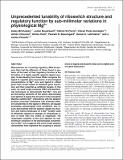Files in this item
Unprecedented tunability of riboswitch structure and regulatory function by sub-millimolar variations in physiological Mg2+
Item metadata
| dc.contributor.author | McCluskey, Kaley Allyn | |
| dc.contributor.author | Boudreault, Julien | |
| dc.contributor.author | St-Pierre, Patrick | |
| dc.contributor.author | Perez Gonzalez, Cibran | |
| dc.contributor.author | Chauvier, Adrien | |
| dc.contributor.author | Rizzi, Adrien | |
| dc.contributor.author | Beauregard, Pascale B | |
| dc.contributor.author | Lafontaine, Daniel A | |
| dc.contributor.author | Penedo-Esteiro, Juan Carlos | |
| dc.date.accessioned | 2019-05-03T10:30:01Z | |
| dc.date.available | 2019-05-03T10:30:01Z | |
| dc.date.issued | 2019-07-09 | |
| dc.identifier | 258630324 | |
| dc.identifier | 25532c44-608f-4c62-ae82-2777522e9231 | |
| dc.identifier | 85069294521 | |
| dc.identifier | 000475891900041 | |
| dc.identifier.citation | McCluskey , K A , Boudreault , J , St-Pierre , P , Perez Gonzalez , C , Chauvier , A , Rizzi , A , Beauregard , P B , Lafontaine , D A & Penedo-Esteiro , J C 2019 , ' Unprecedented tunability of riboswitch structure and regulatory function by sub-millimolar variations in physiological Mg 2+ ' , Nucleic Acids Research , vol. 47 , no. 12 , pp. 6478–6487 . https://doi.org/10.1093/nar/gkz316 | en |
| dc.identifier.issn | 0305-1048 | |
| dc.identifier.other | ORCID: /0000-0002-5807-5385/work/74872772 | |
| dc.identifier.uri | https://hdl.handle.net/10023/17639 | |
| dc.description.abstract | Riboswitches are cis-acting regulatory RNA biosensors that rival the efficiency of those found in proteins. At the heart of their regulatory function is the formation of a highly specific aptamer–ligand complex. Understanding how these RNAs recognize the ligand to regulate gene expression at physiological concentrations of Mg2+ ions and ligand is critical given their broad impact on bacterial gene expression and their potential as antibiotic targets. In this work, we used single-molecule FRET and biochemical techniques to demonstrate that Mg2+ ions act as fine-tuning elements of the amino acid-sensing lysC aptamer's ligand-free structure in the mesophile Bacillus subtilis. Mg2+ interactions with the aptamer produce encounter complexes with strikingly different sensitivities to the ligand in different, yet equally accessible, physiological ionic conditions. Our results demonstrate that the aptamer adapts its structure and folding landscape on a Mg2+-tunable scale to efficiently respond to changes in intracellular lysine of more than two orders of magnitude. The remarkable tunability of the lysC aptamer by sub-millimolar variations in the physiological concentration of Mg2+ ions suggests that some single-aptamer riboswitches have exploited the coupling of cellular levels of ligand and divalent metal ions to tightly control gene expression. | |
| dc.format.extent | 10 | |
| dc.format.extent | 2625380 | |
| dc.language.iso | eng | |
| dc.relation.ispartof | Nucleic Acids Research | en |
| dc.subject | QH301 Biology | en |
| dc.subject | NDAS | en |
| dc.subject.lcc | QH301 | en |
| dc.title | Unprecedented tunability of riboswitch structure and regulatory function by sub-millimolar variations in physiological Mg2+ | en |
| dc.type | Journal article | en |
| dc.contributor.institution | University of St Andrews. School of Physics and Astronomy | en |
| dc.contributor.institution | University of St Andrews. Biomedical Sciences Research Complex | en |
| dc.contributor.institution | University of St Andrews. Centre for Biophotonics | en |
| dc.identifier.doi | https://doi.org/10.1093/nar/gkz316 | |
| dc.description.status | Peer reviewed | en |
This item appears in the following Collection(s)
Items in the St Andrews Research Repository are protected by copyright, with all rights reserved, unless otherwise indicated.

